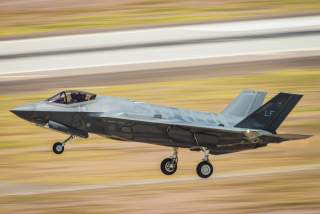Why the F-35 Stealth Fighter Program Couldn’t Get A Bank Loan
If you’re a small business owner and you ask the bank for a loan, you had better be prepared to show them a detailed business plan. But when it comes to spending billions on a jet fighter, that’s apparently not the case.
If you’re a small business owner and you ask the bank for a loan, you had better be prepared to show them a detailed business plan.
But when it comes to spending billions on a jet fighter, that’s apparently not the case.
The F-35 program is preparing to begin development and testing of Block 4 improvements in the aircraft, which will incorporate new weapons, such as the Small Diameter Bomb, as well as collision avoidance technology. The goal is to maintain continuous updates of the F-35, now entering the 18th year of the program, to keep pace with the latest threats.
But the Pentagon hasn’t presented a business case, or baseline cost and schedule estimates, for Block IV improvements, which are expected to reach $10.5 billion by 2024. “Key documents for establishing the business case, such as an independent cost estimate and an independent technology assessment, will not be complete until after the program plans to award development contracts,” according to a Government Accountability Office report. “Without a business case -- consistent with acquisition best practices -- program officials will not have a high level of confidence that the risk of committing to development has been reduced adequately prior to contract awards. Moving ahead without a business case puts F-35 modernization at risk of experiencing cost and schedule overruns similar to those experienced by the original F-35 program during its development.”
And even that $10.5 billion figure is questionable. The Pentagon’s Cost Assessment and Program Evaluation office is supposed to conduct an independent cost assessment of Block IV. “According to CAPE officials, they will provide the independent cost estimate between October and December 2019 to support the program’s full-rate production decision, but this would occur several months after the program plans to award the Block 4 development contracts,” GAO warns. “Without an independent cost estimate, Congress does not have insight into the full potential cost of the Block 4 effort.”
This is consistent with the whole approach of the F-35 program, in which a remarkable decision was made to begin production of the aircraft in 2007 before development was even completed. Critics say that buying and developing a complex aircraft at the same time has contributed to cost overruns, delays and equipment problems in the trillion-dollar program.
How the F-35 program is doing now depends on whether you view the glass as half-full or half-empty. A key measure of the F-35’s success is how it scores on eight Reliability and Maintenance metrics, such as the number of flight hours between systems failure, how long it takes to repair the aircraft, and the probability that it can successfully complete a mission.
“The F-35 program has made slow, sustained progress in improving the F-35’s R&M,” GAO concluded. “R&M determines the likelihood that the aircraft will be in maintenance rather than available for operations. Each F-35 aircraft variant is measured against eight R&M metrics, four of which are in part of the contract. All F-35 variants are generally performing near or above targets for half of the R&M metrics while the other four are still falling short, which is the same as last year. While the program is on track to meet the targets for half of the metrics, the program has not taken adequate steps to ensure the targets for the others will be met.”
Michael Peck is a contributing writer for the National Interest. He can be found on Twitter and Facebook.

